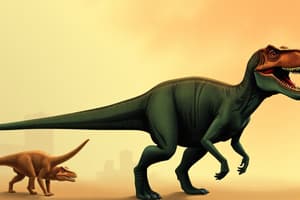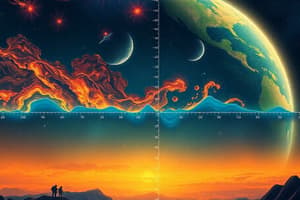Podcast
Questions and Answers
What is the principle of superposition?
What is the principle of superposition?
- Only fossils dictate the age of the layers.
- Younger rocks and fossils are found at the bottom.
- Oldest rocks and fossils are found at the bottom. (correct)
- Rocks are layered randomly without a specific order.
Which of the following units represents the longest amount of geologic time?
Which of the following units represents the longest amount of geologic time?
- Eons (correct)
- Periods
- Eras
- Epochs
Which era is known for the development of mammals and birds?
Which era is known for the development of mammals and birds?
- Paleozoic
- Cenozoic (correct)
- Mesozoic
- Proterozoic
What is typically true about adaptations observed in a population?
What is typically true about adaptations observed in a population?
Which of the following is the shortest unit of geologic time?
Which of the following is the shortest unit of geologic time?
What percentage of all marine and terrestrial species became extinct during the Late Triassic?
What percentage of all marine and terrestrial species became extinct during the Late Triassic?
What event allowed dinosaurs to become the dominant land animals on Earth?
What event allowed dinosaurs to become the dominant land animals on Earth?
What concept suggests that the laws of nature have remained constant over time?
What concept suggests that the laws of nature have remained constant over time?
Which of the following groups was completely wiped out during the Late Cretaceous extinction?
Which of the following groups was completely wiped out during the Late Cretaceous extinction?
Which of the following factors can lead to changes in gene pools?
Which of the following factors can lead to changes in gene pools?
What is another name for the Late Cretaceous extinction event?
What is another name for the Late Cretaceous extinction event?
Which statement is true regarding mutations in genes?
Which statement is true regarding mutations in genes?
Which of the following species were affected during the Late Cretaceous extinction?
Which of the following species were affected during the Late Cretaceous extinction?
What process describes the development and diversification of living organisms over time?
What process describes the development and diversification of living organisms over time?
What does non-random mating imply about mate selection?
What does non-random mating imply about mate selection?
What percentage of all species were lost during the Late Permian extinction?
What percentage of all species were lost during the Late Permian extinction?
How many mass extinctions have occurred in Earth's history?
How many mass extinctions have occurred in Earth's history?
During which extinction event did 85% of marine species vanish?
During which extinction event did 85% of marine species vanish?
Which extinction event is noted for having a severe impact on marine life and reef-builders?
Which extinction event is noted for having a severe impact on marine life and reef-builders?
What is true about the vulnerability to extinction throughout Earth's history?
What is true about the vulnerability to extinction throughout Earth's history?
Flashcards
Principle of Superposition
Principle of Superposition
Oldest rocks and fossils are at the bottom, youngest at the top.
Eons
Eons
Longest units of geologic time.
Eras
Eras
Second longest units of geologic time.
Periods
Periods
Signup and view all the flashcards
Epochs
Epochs
Signup and view all the flashcards
Uniformitarianism
Uniformitarianism
Signup and view all the flashcards
Evolution
Evolution
Signup and view all the flashcards
Gene pool changes
Gene pool changes
Signup and view all the flashcards
Non-random mating
Non-random mating
Signup and view all the flashcards
Mutations
Mutations
Signup and view all the flashcards
Mass Extinctions
Mass Extinctions
Signup and view all the flashcards
Late Ordovician Extinction
Late Ordovician Extinction
Signup and view all the flashcards
Late Devonian Extinction
Late Devonian Extinction
Signup and view all the flashcards
Late Permian Extinction
Late Permian Extinction
Signup and view all the flashcards
Vulnerable species
Vulnerable species
Signup and view all the flashcards
Late Triassic Extinction
Late Triassic Extinction
Signup and view all the flashcards
End-Triassic Extinction
End-Triassic Extinction
Signup and view all the flashcards
K-T Extinction
K-T Extinction
Signup and view all the flashcards
Late Cretaceous Extinction
Late Cretaceous Extinction
Signup and view all the flashcards
What caused the Late Triassic extinction?
What caused the Late Triassic extinction?
Signup and view all the flashcards




